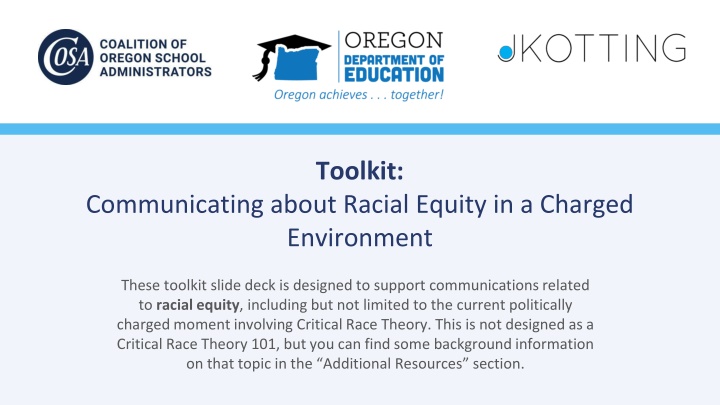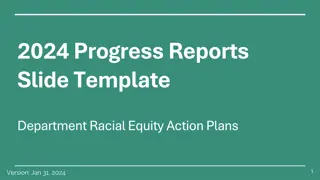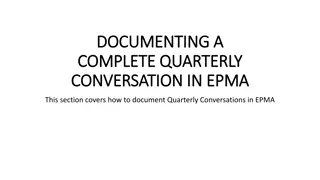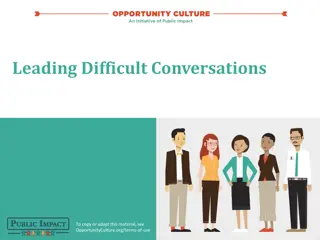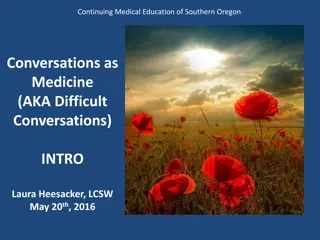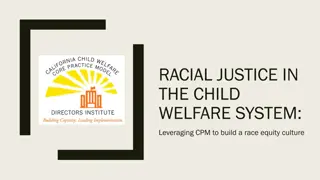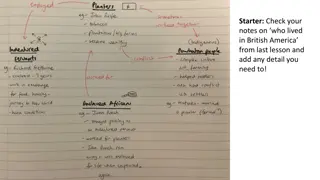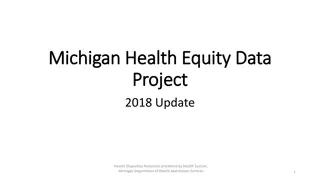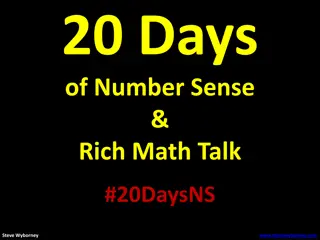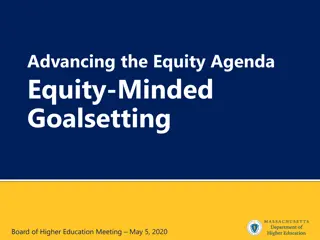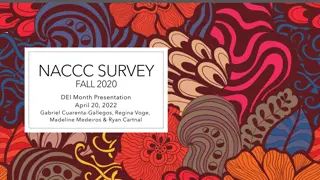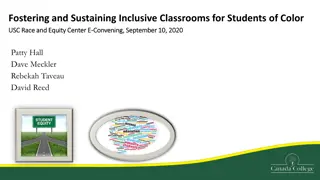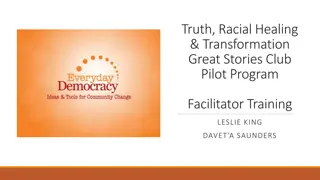Navigating Challenging Conversations About Racial Equity
This toolkit slide deck aims to support communication on racial equity in a charged environment, focusing on effective approaches and the importance of preparing for difficult discussions. It provides strategies for setting boundaries, connecting with others, and handling emotions during conversations about racial equity. Additionally, it offers sample messages for various situations to facilitate constructive dialogues in the school community.
Download Presentation

Please find below an Image/Link to download the presentation.
The content on the website is provided AS IS for your information and personal use only. It may not be sold, licensed, or shared on other websites without obtaining consent from the author.If you encounter any issues during the download, it is possible that the publisher has removed the file from their server.
You are allowed to download the files provided on this website for personal or commercial use, subject to the condition that they are used lawfully. All files are the property of their respective owners.
The content on the website is provided AS IS for your information and personal use only. It may not be sold, licensed, or shared on other websites without obtaining consent from the author.
E N D
Presentation Transcript
Toolkit: Communicating about Racial Equity in a Charged Environment These toolkit slide deck is designed to support communications related to racial equity, including but not limited to the current politically charged moment involving Critical Race Theory. This is not designed as a Critical Race Theory 101, but you can find some background information on that topic in the Additional Resources section.
Why prepare for challenging conversations about racial equity? All around the U.S. and in the state, conversations are happening around racial equity in practice in schools. Being responsive and setting clear expectations for what students will experience in the classroom can be beneficial to relationships in the school community. Also, it s crucial that students, educators, and staff feel supported in their work towards racial equity through tensions that may arise. Above all, the goal is to bridge divides and ensure that every student feels welcome and a sense of belonging at school so they can reach their full potential.
Effective approaches to challenging conversations: Start the conversation with boundaries and clarity Invite direct conversation to prevent spread & escalation I d like to connect with you about your concerns directly. Would you be willing to speak with me one-on-one before you bring your concerns to other groups of people? Set time, tone, and purpose (in advance if you can). I m looking forward to a constructive conversation during our 30 minutes together. First, I d like to hear more about your perspective, and I ll fill you in about how decisions are being made towards the end. Establish connection I want to get to know you better and Let s figure this out together. Ask for clarity Help me understand better why you re saying / Tell me more about your concerns when it comes to Use tone and non-verbal cues to your advantage
Effective approaches to challenging conversations: Ground Your Conversation 1. What is the vision for equity in your district? 2. What is your plan and what steps are you taking next? 3. What are some key turning points and experiences you can share? 4. What is the experience of people most impacted that you ve engaged with? 5. What is your responsibility as a leader?
Effective approaches to challenging conversations: Spectrum of Emotion OPPOSITION: VIOLENCE CONTEMPT AVERSION TRANSITION: DISCOMFORT SUSPICION AMBIVALENCE SUPPORT: ACCEPTANCE AFFIRMATION ACTIVISM
Sample messages for a range of situations and emotions We can move forward as planned with our school year if we commit to building strong relationships in our community and having direct conversations about issues that arise. I see how much you care about your child. I hope you can understand that it s my responsibility to show the same level of care for all students in our [school/district] so it s important that I can listen and hear concerns from many different people. Young people are curious and need time and space in school to talk about what s happening in the world around them. Talking about race and different cultures isn t about blame; it s about understanding each other.
Sample messages for a range of situations and emotions Our work to [describe equity/culturally responsive work] is designed to benefit the specific students in our district who haven t been included in the past. Our education system and curriculum need to keep up with what students in our district are asking for. That means teaching in an honest and inclusive way, and addressing current events to prepare young people for their future lives and careers. Let s support educators to reinforce equity in the classroom, and let s trust students to share and learn about what s happening in the world around them. If you speak to other [parents/community members], would you be willing to share some of what we talked about so their concerns can be alleviated?
4 Messages about Critical Race Theory 1. Ask: When you say "Critical Race Theory" I'm curious what you're referring to specifically in our curriculum. Are you willing to tell me more and also hear more from me about what's really happening in our classrooms? 2. It is true that Critical Race Theory is mainly used in higher education and is not a required part of any curriculum used in our district. However, a lot of people are using the label of Critical Race Theory to refer to anything related to racial equity. 3. Critical Race Theory helps people describe how racial inequity is baked into all of our social and political structures - it's about institutions and laws, not blaming individuals or examining interpersonal dynamics. 4. Indoctrination through Critical Race Theory just isn't happening. Young people are curious and are going to talk about issues related to race and other identities. We need to equip students with the tools they need. to think critically about issues of race, racism, and inequity.
Effective approaches to challenging conversations: Continuing and ending the conversation Empathize and ask for fair consideration in return I see how much you care about your child. I hope you can understand that it s my responsibility to show the same level of care for all students in our [school/district]... that s why Establish expectations and gain consent to offer clarity Based on what you shared earlier, I believe I can alleviate your concerns by providing you with more information. Would you like to learn more? Support staff with success stories Consider sharing a story about that educator in action or about a similar classroom activity and how you ve seen it work well. End the conversation with an ask Thank you for your time today. As you continue to think about this issue, I hope you will bring additional questions and concerns to me directly.
Effective approaches to challenging conversations: Approaches to consider, depending on the situation Describe what really happens in the classroom and alleviating fears of worst case scenarios. Share an end goal that is difficult to disagree with. Emphasize efforts & responsibility to bring people together. Get real with people about pain points but talking about what is possible now and in the future. Emphasize the importance of students feeling connected to the curriculum they are receiving.
MEDIA REQUESTS: TOP 10 TIPS 1. Vet thoroughly before accepting. 2. Set aside time to prepare. 3. The reporter is not your audience. 4. Start from a place of strong values. Also see detailed notes below slide. 5. Decide on a personal story. 6. Don t dwell on details or past mistakes. 7. Know what NOT to say. 8. Avoid repeating what you disagree with. 9. Seek support as needed. 10. Prepare the final thing you d like to say.
BRIDGING TECHNIQUES 1. Let me tell you what the real issue is 2. I don t know about that, but what I can say is 3. That may be up for debate right now, but what isn t up for debate is 4. I can tell you from my own experience 5. I can t speak to that, but I can tell you that 6. I ve been [teaching/working in education] for X years and what I ve seen is 7. That s not quite right. The fact of the matter is 8. That s not what the pushback around Critical Race Theory is truly about. It s about... 9. Our only agenda is improving education and equity for each and every student. 10. It s important to understand that at the heart of the issue is...
HOW TO PREPARE THOROUGHLY FOR INTERVIEWS 1. Who am I talking to (Who is my real audience)? 2. What do I want to say (What are my top three messages)? A good message is a short, compelling roadmap that does three things: a. Defines the problem you re trying to solve b. Outlines your broad vision for a solution c. Offers specific actions your audiences can take to solve the problem 3. What s the toughest question I might be asked? How do I want to respond? Share in chat.
COMMUNICATIONS & ENGAGEMENT PLANNING Pre-Step 1: Plan for and work to prevent crises. It s a good idea to meet with your core staff at least annually to prepare for potential crises. Discuss and write down what you envision might be possible, what you might do to prevent the issue from happening (such as working on school climate and healing activities within your school community). Pre-Step 2: Assess your starting conditions. What is your interior condition? What kind of a situation is this? What is your timeline for when you need to act or respond? Also see the ODE Decision Tool. Pre-Step 3: Investigate thoroughly. Before planning and taking any action, gather and verify information; notify people who need to know what s happening prior to your public response and before wider engagement begins; and prepare a document with information, details, questions, and process undertaken in case you need a clear report.
COMMUNICATIONS & ENGAGEMENT PLANNING In a crisis or rapid response situation, consider these steps. Step 1. Assess the Situation Before Taking Action Step 2: List 3 Desired Results Step 3: Plan Engagement Step 4: Decide on Approach Step 5: Create Communication Strategy Step 6: Refine Key Messages
